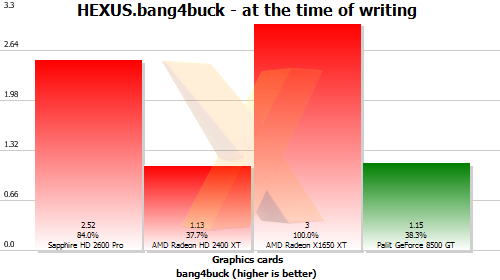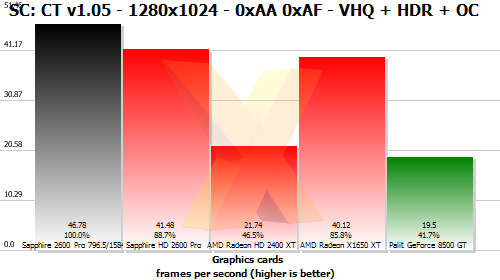HEXUS.bang4buck, HD video-decode, and overclocking
HEXUS.bang4buck

Now, the HEXUS.bang4buck graph simply divides the normalised marks by the current price, to give you an easy-to-understand metric that takes value into account.
We see that the Sapphire Radeon HD 2600 PRO's reasonable DirectX and OpenGL performance translates into a healthy HEXUS.bang4buck. The ~£50 Radeon HD 2400 XT and GeForce 8500 GT's stunted architectures provide sub-optimal framerates and, thus, poor normalised scores, which takes playable framerates into account.
The Sapphire Radeon HD 2600 PRO performs in reasonably similar fashion to the previous-generation's Radeon X1650 XT when evaluated without antialiasing and anisotropic filtering, but it has other tricks up the RV630 sleeve to ensure it's a well-rounded solution. Video-decode performance is one of them...
HD-DVD video-decode performance
Digital PC-based full-resolution playback of commercially-available HD-DVD and Blu-ray titles requires an HDCP-compliant graphics card and display device as well as significant processing power - be it on-GPU or on-CPU - to decrypt and decode the high-definition content that's usually encoded in H.264 or VC-1. MPEG-2 decode is fundamentally less computationally expensive, however.AMD's full range of Radeon HD 2400/2600 graphics cards support on-GPU HDCP support which is allied to the company's UVD (Unified Video Decoder), designed to offload the decode process from the CPU to the GPU.
We've tested the Sapphire's HD-DVD decode qualities by running both H.264 (Babel) and VC-1 (Harry Potter) titles and noting CPU utilisation.
NVIDIA lets its partners decide whether HDCP support is implemented in their low-to-midrange GeForce 8xxx-series SKUs, with the exception being the GeForce 8600 GTS: HDCP support is mandatory.
In view of this, we've pitted the Sapphire PRO against an AMD Radeon HD 2600 XT and an ASUS GeForce 8600 GTS which, at around £125, is significantly more expensive.
Testing was conducted on the following platform:
| GPU manufacturer | AMD | NVIDIA |
| CPU | Intel Core 2 Duo E6600 LGA775 (2.40GHz, 4MiB L2 cache, dual-core) | |
| Motherboard | ASUS P5W-DH Deluxe (975X+ICH7R) | eVGA NF68 (NVIDIA NF6 680i SLI) | Memory | 1GiB (2 x 512MiB) OCZ26671024ELDCGE-K PC5400 |
| HD-DVD drive | Hitachi SD-H802A | |
| Hard drive | 160GB Seagate Barracuda 7200.9 (3Gb/s mode) | |
| Monitor | Dell 3007WFP | |
| Operating system | Microsoft Windows Vista x86 Business Edition 32-bit | |
|---|---|---|
| Drivers | 8.38.9.1-070613a-048912E-ATI (Cat 7.7 BETA) | ForceWare 158.24 | Playback software | CyberLink PowerDVD Ultra 7.3.2911e.0 | Vista desktop resolution | 1920x1080 |
| HD-DVD content | Babel HD-DVD, H.264 AVC, ~25Mb/s, chapter 3, 102s
Harry Potter: Goblet Of Fire HD-DVD, VC-1, ~18Mb/s, chapter 6, 100s |
|
We're using a midrange Microsoft Vista-based platform to compare card-accelerated decoding. PureVideo HD for GeForce 8600 GTS currently does not hook-in with Windows XP. We've also included numbers for CPU-only decode, activated by unticking card-based support.
Note, too, that NVIDIA's settings included activating inverse telecine, setting edge enhancement to 80 per cent, and noise reduction to 100 per cent.
Here's how it panned out.
| Graphics cards | Sapphire Radeon HD 2600 PRO 256MiB | AMD Radeon HD 2600 XT GDDR4 256MiB | ASUS GeForce EN8600GTS 256MiB | CPU-only decode - Sapphire | CPU-only decode - NVIDIA | Babel: percentage CPU utilisation with PowerDVD and UVD/PureVideo HD on (lower is better) | 19.96 | 20.15 | 20.92 | 69.31 | 67.96 | Harry Potter: percentage CPU utilisation with PowerDVD and UVD/PureVideo HD on (lower is better) | 16.92 | 17.06 | 31.88 | 49.71 | 41.07 |
|---|
H.264 decode is pretty even amongst the tested cards but VC-1 CPU utilisation is markedly lower on both AMD Radeon HD 2600 SKUs. Still, having your midrange CPU chug along at ~30 per cent whilst decoding 1080p isn't problematic.
Overclocking
We managed to raise the default frequencies of 695.25/1386 to 796.5/1584 without having to resort to additional cooling. Re-running Splinter Cell: Chaos Theory at 1280x1024 HDR...
Produces a near-13 per cent gain. Worthwhile, definitely, but your individual mileage will vary.









